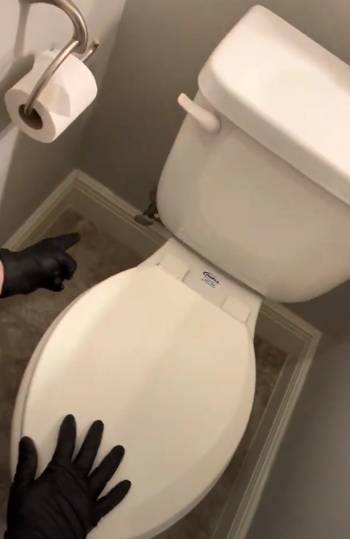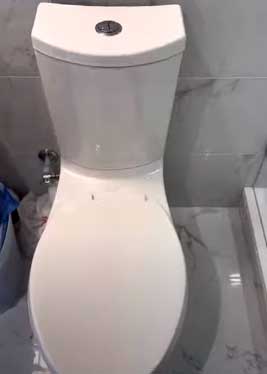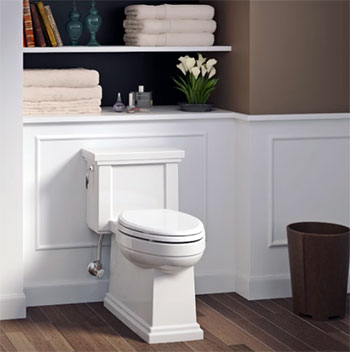The toilet is one of the most common and widely used utilities in a household. And yet, the design of this essential fixture is often left to chance.
Skirted toilets, sometimes called concealed trapway toilets, have become increasingly popular in recent years. As the name suggests, these toilets have a skirt that covers the trapway, creating a sleek, modern look.
As per a report by ENRC Research and Consulting, 60% of all homes face skirted toilet problems. Also, even those who have installed these facilities in their bathrooms do not use them properly.
Issues With Skirted Toilet

The problems with skirted toilets stem from their simple design. These older toilets have a skirt of material around the bowl, and this can get stuck when it’s wet.
This makes it difficult to access the toilet, and wastes time as you have to tug at the skirt until it comes loose.
Another common problem with these toilets is that it doesn’t seal flush toilet properly. So even if you do manage to flush them, water will seep out and cause flooding.
Some of the major problems are described below:
- Leaking from Under the Skirt
One of the most frustrating issues with skirted toilets is leaking from underneath the skirt area. This is often caused by a poor wax ring seal between the toilet and the floor flange. When weight and pressure are applied, small gaps can form, allowing water to seep out.
Catching these leaks early is key to prevent water damage. Signs include water on the floor around the base of the toilet or in the room below on a lower level. Act quickly if you notice either.
- Clogged Traps and Drains
While the covered trapway creates a smooth exterior, it can make clearing clogs more tedious with a skirted toilet. Because you can’t directly access the trap like a traditional toilet, snaking it requires removing the toilet completely.
Start by turning off the water supply line and flushing to empty the tank. Sponge out any remaining water in the bowl. Remove the caps covering the toilet mounting bolts and unscrew the bolts to detach the toilet. Set the toilet aside on cardboard or a towel.
Before snaking, check the drain port openings under the toilet base for obstructions. Then insert the auger in and rotate, advancing it slowly to clear debris or buildup. Once done, reinstall the toilet with a new wax seal and bolts per above. Be sure to check for any leaks.
- Harder to install & service
Skirted toilets are more difficult to install than traditional toilets. They also pose a greater service challenge as the skirt can get stuck and require diligent effort to free it.
- Poor flushing
The poor flushing mechanism of skirted toilets can be attributed to the skirted design of the fittings, as well as the way they are installed.
The installation may not allow for proper sealant around flush system valves to ensure a good water flow. Additionally, obstruction in drainage channels or inadequate flooring cause build-up which affects flushing ability.
- Tank Condensation and Sweating
The concealed tank of a skirted toilet can lead to problematic condensation on the tank exterior. The lack of air circulation allows moisture to build up, especially in humid climates.
Excess condensation dripping down the tank can lead to water damage or mold growth under the skirt.
- Wasteful usage

Despite being easier to use, people often misuse skirted toilets.
Because it’s harder to flush mechanism and the water accumulates in the bowl, people tend to resort to using wet wipes or buckets instead of flushing.
This results in increased wastewater discharge and a greater ecological footprint.
- Waste disposal
The waste from skirted toilets often seeps down into the wastewater system, leading to smells and contamination of water resources.
This problem is especially acute in homes with small sewage systems. In addition, the waste can lead to the leaching of toxic substances into groundwater.
- Flooding
If the toilet heated seat isn’t tight, water can seep through the seams and escape into the modern bathroom. This leads to flooding, which can damage furniture and flooring.
- Bacteria growth
Skirted toilets can also be a breeding ground for bacteria, especially if they are not properly cleaned.
This is because the narrower circumference of the bowl allows more moisture to collect, which provides an ideal environment for harmful bacteria to grow.
- Mismatches
If you have a traditional toilet but choose to install a skirted model, it’s important to make sure that the fixtures are compatible. Otherwise, you’ll end up with leaks and other problems down the line.
- Pricey
Skirted toilets are usually more expensive than traditional models. This is because they require special fittings and materials, which can add up over time.
- Bulky Design
Skirted toilets are often larger and bulkier than their traditional counterparts. This can make them less aesthetically pleasing, and it can also lead to problems with floor open space.
In the long run, skirted toilets can have a negative impact on your home and environmental health. Instead of opting for this type of toilet, it’s often wiser to stick with traditional models that pose less risk.
- Injury risk
People have been known to trip and fall while ascending or descending a skirted toilet. This is especially dangerous if the person has mobility issues or is carrying heavy items.
Toilet installation is a big decision and choosing the right one can be tricky. Make sure to research all of your options before taking the plunge, so that you get the best fit for your needs.
Overall, skirted toilets have several drawbacks that can impact the quality of life and environment. If you’re considering purchasing one, it’s important to weigh all of these factors carefully before making a decision.
Solution To These Problems

If you’re unhappy with the way your traditional toilet looks or performs, it may be time to consider a skirted model.
These toilets offer unique and stylish one-piece toilet design options, as well as improved functionality.
In addition, they tend to be less expensive than traditional models and often take up less space overall.
The problems of the skirted toilet can be solved in many ways-
- Replace the skirt
If your skirted toilet is starting to show signs of wear, it’s time to replace the skirts. This will not only give your toilet a new look but will also improve its functionality.
Skirts can be replaced in a variety of styles and colors, so you’re sure to find one that perfectly fits your needs.
- Upgrade the hardware
Even if you haven’t replaced the skirts on your skirted toilet, it may be time to upgrade the hardware. This includes the bolts that hold the round bowl in place, as well as any plumbing or drainage issues.
Upgrading your hardware will help to improve the performance and durability of your toilet.
- Add a seat
Adding a comfortable seat to your skirted toilet can make a big difference in terms of comfort height and usability.
Seating options range from basic models that simply attach to the skirt, to more elaborate options that include storage and massage functions.
- Add a throw rug
A decorative throw rug can add color and function to your skirted trapway toilet area. Not only will it help you create a stylish space, but it can also be used as a place to sit when needed.
- Consider a skirted bidet
A skirted bidet is a great option if you’re looking for an enhanced toilet experience. These toilets offer users the option to use both hands to wash, as well as customize their spray patterns and temperature settings.
- Install a Toilet Seat Covers

Adding toilet seat covers not only helps to protect your seats from dirt and debris, but it can also add a touch of luxury to your bathroom.
There are many different styles and colors available, so you’re sure to find one that perfectly matches the look and feel of your bathroom.
- Repair or Replace Broken Parts
If one of your toilet’s parts is broken, don’t hesitate to repair or replace it. Doing so will help to improve its functionality and durability, and may even extend the life of your toilet.
If you’re experiencing problems with your toilet, it may be time to consider upgrading the hardware or adding a seat or rug.
Upgrading your hardware will help to improve the performance and durability of your American standard toilet while adding a seat or rug can make a big difference in terms of comfort and usability.
Frequently Asked Questions (FAQ)
There are a few potential drawbacks to using a skirted toilet, but they typically only apply to users who have trouble reaching the back of their toilets.
For most people, these problems are relatively minor and can be easily overcome by adjusting your positioning or height.
When choosing a skirted toilet, it’s important to consider both your budget and your needs. Make sure you research different models to find the one that best suits your needs.
No additional installation equipment or tools are necessary for a skirted bidet; just make sure that the water supply is adequate and that the plumbing is in good condition.
Skirted toilets do offer a more streamlined, modern appearance than a standard toilet with an exposed trapway. However, they don’t necessarily function better than a regular toilet. The concealed design can make repairs and access more difficult. The smooth skirt also shows scratches and damage more easily. Consider both styles to see which look and features suit your needs best.
Installing a skirted toilet is generally more involved than a standard toilet. Precisely measuring and leveling the toilet is crucial to get a good floor seal. The concealed mounting bolts also take some finesse to align and tighten properly. Using a professional installer is advisable to get the positioning and water connections correct.
A skirted toilet has a decorative skirt covering the trapway and supply connections. A concealed toilet goes a step further by hiding the tank and all plumbing within a wall framed out behind the bowl. Concealed toilets require major remodeling but provide the most seamless look.
Conclusion
Skirted toilets are a great option for those who want an easier time choosing the right level of flushing system.
However, they come with their own set of drawbacks, which include increased wastewater discharge and ecological footprinting. It’s important to make sure that you’re using them properly so that skirted toilet problems don’t occur.

